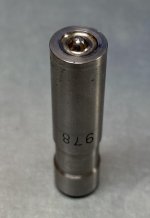Nerdlinger
Stainless
- Joined
- Aug 10, 2013
- Location
- Chicago, IL
Hi Everyone!
We have an application where we peen over a .156" diameter X .750" long solid rivet with a hammer. The rivet is steel, hardened to 40-42 HRC. I drilled a small hole in the end to make it semi-tubular and it formed over beautifully with a standard set. I got tired of modifying them by putting them in a speed lathe one at a time to drill out the hole so I made a bunch out of 4140 in a CNC and heat treated them but those split when set (that is, the portion that got formed/rolled over split.) I tried waxing them but no improvement. I imagine there is some difference between the material that the lifetime supply of solid rivets we have is made of and 4140 or it has something to do with the cold forming the solid rivets underwent. Does anyone know what a good steel alloy would be to make a semi-tubular rivet out of in a CNC lathe that can also be hardened to ~40 HRC?
Thank you!
Disclaimer - I am NOT a rivet guy so I apologize if my terminology is off.
We have an application where we peen over a .156" diameter X .750" long solid rivet with a hammer. The rivet is steel, hardened to 40-42 HRC. I drilled a small hole in the end to make it semi-tubular and it formed over beautifully with a standard set. I got tired of modifying them by putting them in a speed lathe one at a time to drill out the hole so I made a bunch out of 4140 in a CNC and heat treated them but those split when set (that is, the portion that got formed/rolled over split.) I tried waxing them but no improvement. I imagine there is some difference between the material that the lifetime supply of solid rivets we have is made of and 4140 or it has something to do with the cold forming the solid rivets underwent. Does anyone know what a good steel alloy would be to make a semi-tubular rivet out of in a CNC lathe that can also be hardened to ~40 HRC?
Thank you!
Disclaimer - I am NOT a rivet guy so I apologize if my terminology is off.




